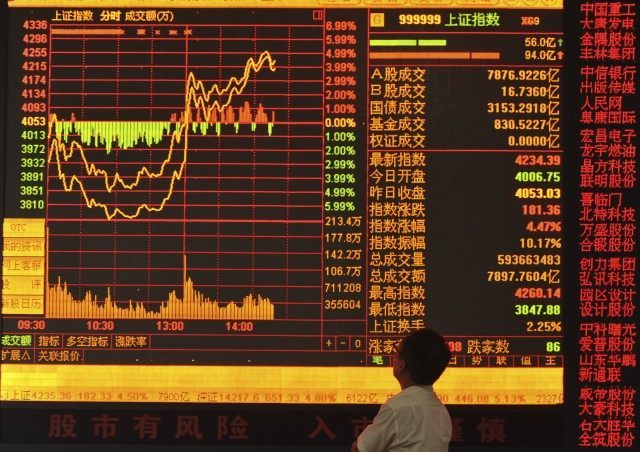Promising to reverse a stock market crash over the last 14 trading days that has been worse than the US crash in October 2008, China’s state-owned banks, stock brokers, and fund managers committed $200 billion to rescue stock prices over the weekend.
But despite opening up +8 percent, Chinese stock prices gave up all but a +2 percent gain by the end of trading. China’s rescue effort is starting to remind traders of the failed bank rescue of Wall Street in 1929 that preceded “Black Tuesday.”
This weekend’s lead editorial in The People’s Daily, the most influential propaganda organ of the ruling Communist Party, stated, “Rainbows always appear after rains” to reassure the millions of retail investors that make up 85% of total stock market participants in China, compared with just 25% in America. The Daily boastfully added, “(China has) the conditions, ability and confidence in maintaining capital market stability.”
The “all-in” strategy followed a week that included an interest-rate cut by the People’s Bank of China and dramatic relaxations in margin trading and other “stability measures” in a failed effort to reassure investor as the China stock indexes fell by over 12 percent.
Monday’s rescue of stock prices had the full Chinese government’s support as evidenced by direct loans from the People’s Bank of China to the entire state-owned financial sector spiked prices +8 percent on the morning market opening. But by the close of trading, stocks had fallen back and closed at their lows for the day. The CSI300 index of the largest listed companies in Shanghai and Shenzhen held on to a +2.5 percent gain, while the Shanghai Composite Index was up +2.2 percent.
Fear that China was losing control of the markets gripped the other big developing markets in Asia. Japan’s Nikkei fell -2.42 percent; Hong Kong’s Hang Seng was lower by -4.02 percent; and South Korea’s Kospi was off -2.11 percent.
China’s financial sector moving in lock-step eerily reminds historians of the high expectations surrounding the initial success of the Friday, October 24, 1929 rescue of the New York Stock Exchange that was put together by commitments from J.P. Morgan, Guaranty Trust Company, and Chase National Bank to buy blue chip stocks at above market prices.
The tactic worked so well before the weekend that the Sunday’s New York Times lead editorial lauded the “carefully arranged” plan to boost the market and reassured readers that “the danger of panic had been averted,” since First National Bank would be included in what was called Wall Street’s “buyers’ pool” for the next day’s trading.
But when markets re-opened on Monday, October 28, 1929, a record number of shares were traded by panicked retail investors as the stock market plummeted by more than -13 percent. The next day became the infamous “Black Tuesday,” October 29, 1929, when 16 million shares were traded and the stock market lost $14 billion for the day.
Monday’s China “buying group” was led by China brokerage leaders, Citic Securities Co. and Guotai Junan Securities Co.. They organized a group of 21 Chinese brokerages that collectively committed on Friday evening to purchase $19.3 billion in shares to stabilize stock prices. They were joined by China Mutual Fund Association’s 25 investment fund companies who pledged on Saturday to buy shares and another 69 fund firms that said on Sunday they would also be buyers.
Chinese stock markets opened on a tsunami of buy order. But those prices sold off during the day to close off by -6 percent from the opening. That would seem to indicate that China’s “buying group” has a collective loss of up to -$1.2 billion.
The United States government and the big American banks in 1929 were just as confident as the Chinese government is today that their banks can stop a stock market crash. That confidence evaporated in the US on “Black Tuesday.” Financial institutions around the world will be intensely watching China this Tuesday.

COMMENTS
Please let us know if you're having issues with commenting.